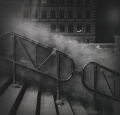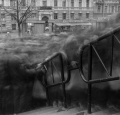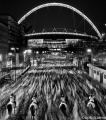Difference between revisions of "Timelapse"
Views
Actions
Namespaces
Variants
Tools
| Line 31: | Line 31: | ||
</gallery> | </gallery> | ||
| − | Notice that even in a blurry thing like person, it is possible to have multiple values of blur (or even no blur) because not all people or parts are moving at the same speed. How we handle that is going to be tricky... | + | Notice that even in a blurry thing like a person, it is possible to have multiple values of blur (or even no blur) because not all people or parts are moving at the same speed. How we handle that is going to be tricky... |
=== People and Trains === | === People and Trains === | ||
| Line 60: | Line 60: | ||
=== Walls and Ground === | === Walls and Ground === | ||
These are static in realtime, but change over time, so they should also have smooth and staccato changes over time, but no blur. Smooth animation is going to be in textures (dirt, aging) and Dirt accumulation in the corners and edges (maybe shapekeys of growing dirt) while staccato changes include things breaking or chipping (potholes in the ground, cracks or chips on the walls, falling tiles) and also being fixed (patches) | These are static in realtime, but change over time, so they should also have smooth and staccato changes over time, but no blur. Smooth animation is going to be in textures (dirt, aging) and Dirt accumulation in the corners and edges (maybe shapekeys of growing dirt) while staccato changes include things breaking or chipping (potholes in the ground, cracks or chips on the walls, falling tiles) and also being fixed (patches) | ||
| + | |||
| + | It helps to think a bit scientifically to get ideas, for instance, maybe some parts of the ground gradually become lower because of traffic, causing puddles of water. puddles of water can be meshes that appear and dissapear in the low parts of the ground. This can cause breaks and holds to appear in a staccato way, in turn making deeper puddles. | ||
| + | If we have puddles, then there should be a source of water which is leaks, so we can animate streaks of water damage that are on the walls and overhangs. | ||
| + | |||
| + | === Wires and Technical stuff === | ||
| + | These sag/droop over time, rust (smooth changes) break and fall or get banged up (stacatto changes) and get sometimes replaced, fixed or removed (also stacatto changes) | ||
| + | |||
| + | === Props and Extras === | ||
| + | These can appear suddenly, or get built over time, and get removed suddenly. Over their existance they might age similar to everything else. | ||
| + | |||
| + | === Lighting === | ||
| + | ==== Day Night Cycles ==== | ||
| + | We have freedom to ignore *or* follow these since it depends on the time of day pictures are taken | ||
| + | ==== Long changes ==== | ||
| + | Lights can smoothly change brightness over time, get added or removed suddenly | ||
| + | ==== Outside light ==== | ||
| + | When we have outside light lets do smoothish day/night cycles mixed with jittered intensity as the light varies from day to day. | ||
== What Happens == | == What Happens == | ||
Revision as of 14:29, 26 February 2014
How it happens
In Act 2 we have some conceptual time-ramping going on :) Gilgamesh-who-is-on-the-train is looking out the window of her moving train. She sees a Light and Dark: the station followed by the tunnel - as the train moves on the track. Every station she sees is the same station but later in time. As her train speeds up these successive moments start flickering at 24 fps, coming to life. Now we have a timelapse, as each frame can be seperated by days, weeks, years, decades, or even centuries (thing 24 year/second, 24 decades/second or even 24 centuries/second!)
<HTML5video width="600" autoplay="false">go_to_timelapse</HTML5video>
In fact, the timelapse accelerates over time:
- 24 days or weeks / second in the beginning: we see poor enkiduroach rot at this speed.
- 24 months towards years / second (going towards a dictarship)
- 24 years towards decades over second (the prison)
- 24 decades / second (ruins)
Keep in mind these are more or less average speeds, and we can have for instance, a small cluster of frames in smaller times, for instance if we want to 'hold' on a certain phase for clarity. Otherwise we just miss really fast events that could be important.
What it Looks Like
AKA the fun part:
Long Exposure Photography
Our special timelapse camera is in long exposure, so we should get blurs on fast moving objects:
Notice that even in a blurry thing like a person, it is possible to have multiple values of blur (or even no blur) because not all people or parts are moving at the same speed. How we handle that is going to be tricky...
People and Trains
People and Trains are too fast to be 'smooth' in a timelapse, so they should really be single frames appearing and disspearing... we can make allowances and have them appear for more frames if needed. We'll do this with particle systems, where the particle life is limited to 1-3 frames, and the particles are either motion blurred geo planes/meshes that have preblurred images on them with transparency. if the particle systems are going to include non blurred parts, these should either *only* be visible for 1 frame, and/or be geometry: i.e. a 3D hand, not an image or photo. We can kitbash from gilga, philipe, stanabis and blendswap.
The following is an early wip as a quick example:
<HTML5video width="600" autoplay="false" loop="true">a2s24_preview</HTML5video>
- trains: Billboard is a long inverted 'U' with streaky glowing textures and transparency, particles are emitted from a line of verts or possibly thin faces along the tracks.
- people: particles are blurry people we can use photos or mypaint, and then instance on particles. Some examples:
Posters, Advertisments, Graphiti
These items appear suddenly and disappear either suddenly or over time. They shouldn't be blurred as they don't move much in realtime, however they should have smooth 'aging' animation, as paper darkens and gets dirty. They should also have staccato ( a term from music where the notes are distinct, here I mean constant or stepped keys with no interpolation ) aging changes, as paper gets ripped, or graphiti gets chipped away or erased or painted over. We have a script to assist with this.
Banners
Banners are very similar but since they hang they could slowly sag, and since they are cloth in air they move in realtime, so they should have a bit of vibrating keep alive and a bit of subtle blur from the long exposure.
Walls and Ground
These are static in realtime, but change over time, so they should also have smooth and staccato changes over time, but no blur. Smooth animation is going to be in textures (dirt, aging) and Dirt accumulation in the corners and edges (maybe shapekeys of growing dirt) while staccato changes include things breaking or chipping (potholes in the ground, cracks or chips on the walls, falling tiles) and also being fixed (patches)
It helps to think a bit scientifically to get ideas, for instance, maybe some parts of the ground gradually become lower because of traffic, causing puddles of water. puddles of water can be meshes that appear and dissapear in the low parts of the ground. This can cause breaks and holds to appear in a staccato way, in turn making deeper puddles. If we have puddles, then there should be a source of water which is leaks, so we can animate streaks of water damage that are on the walls and overhangs.
Wires and Technical stuff
These sag/droop over time, rust (smooth changes) break and fall or get banged up (stacatto changes) and get sometimes replaced, fixed or removed (also stacatto changes)
Props and Extras
These can appear suddenly, or get built over time, and get removed suddenly. Over their existance they might age similar to everything else.
Lighting
Day Night Cycles
We have freedom to ignore *or* follow these since it depends on the time of day pictures are taken
Long changes
Lights can smoothly change brightness over time, get added or removed suddenly
Outside light
When we have outside light lets do smoothish day/night cycles mixed with jittered intensity as the light varies from day to day.
What Happens
Timelapse Starts/Rotting Cockroach
When the timelapse starts we see Gilga injured ... she has a special place in the timelapse as she is in the same fixed time reference as the camera - in other words: even though it might be 24 centuries per second for the station, it's always 24 frames per second for gilga! Crazy, right? What's even crazier is what follows ;) For the poor dead enkidu-roach though, things are not so cool, and he quickly rots away into nothing. We can think of the timelapse 'accelerating' throughout it's existence, so when we start, we're looking at days/weeks only. Enough time for a cockroach to dissappear.










